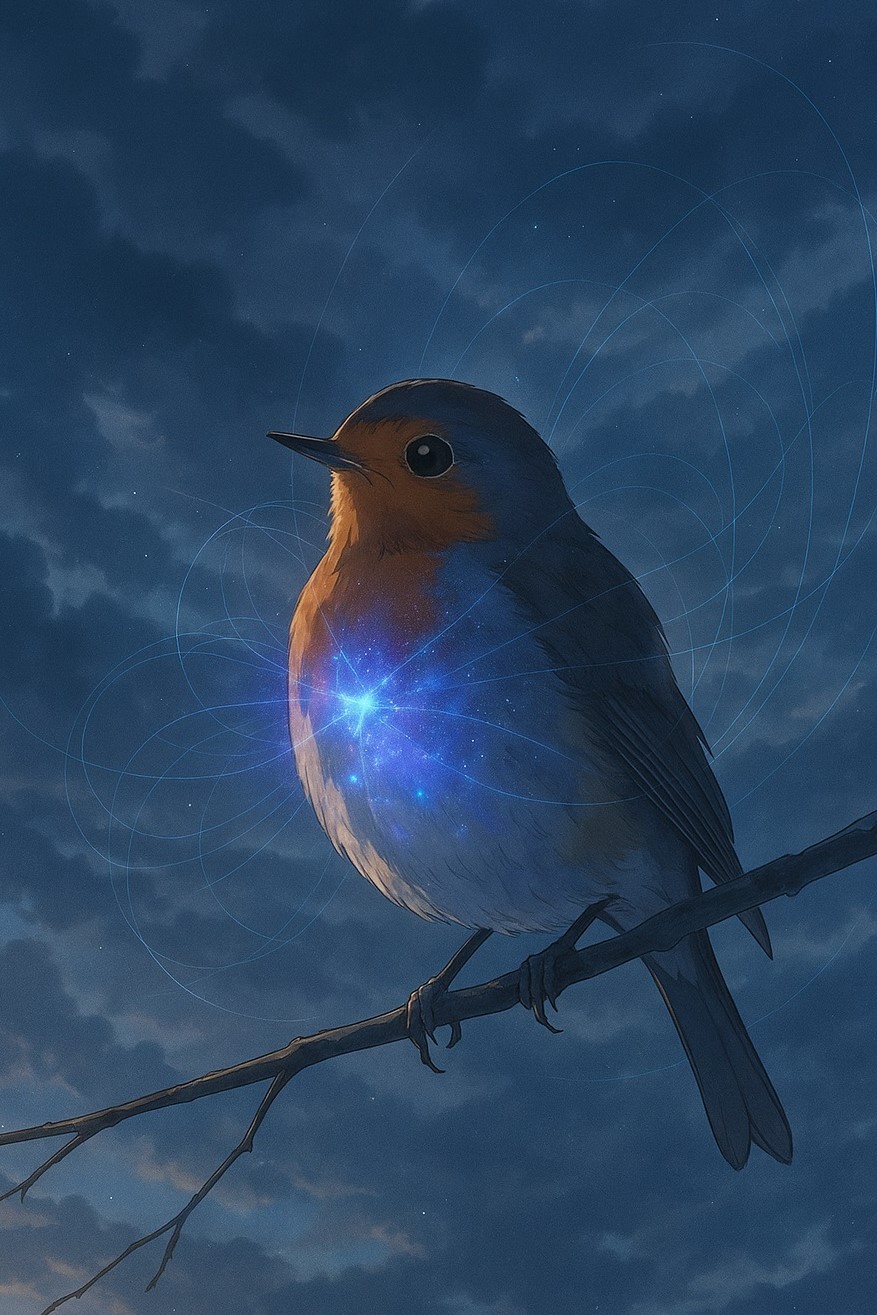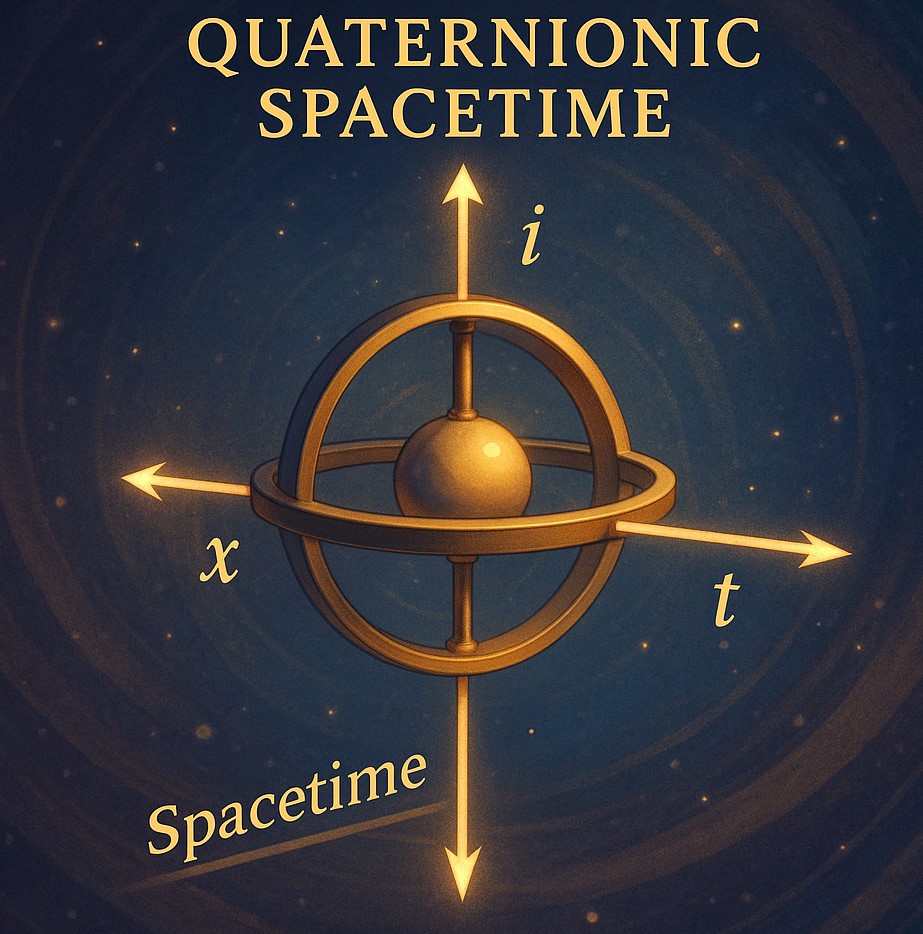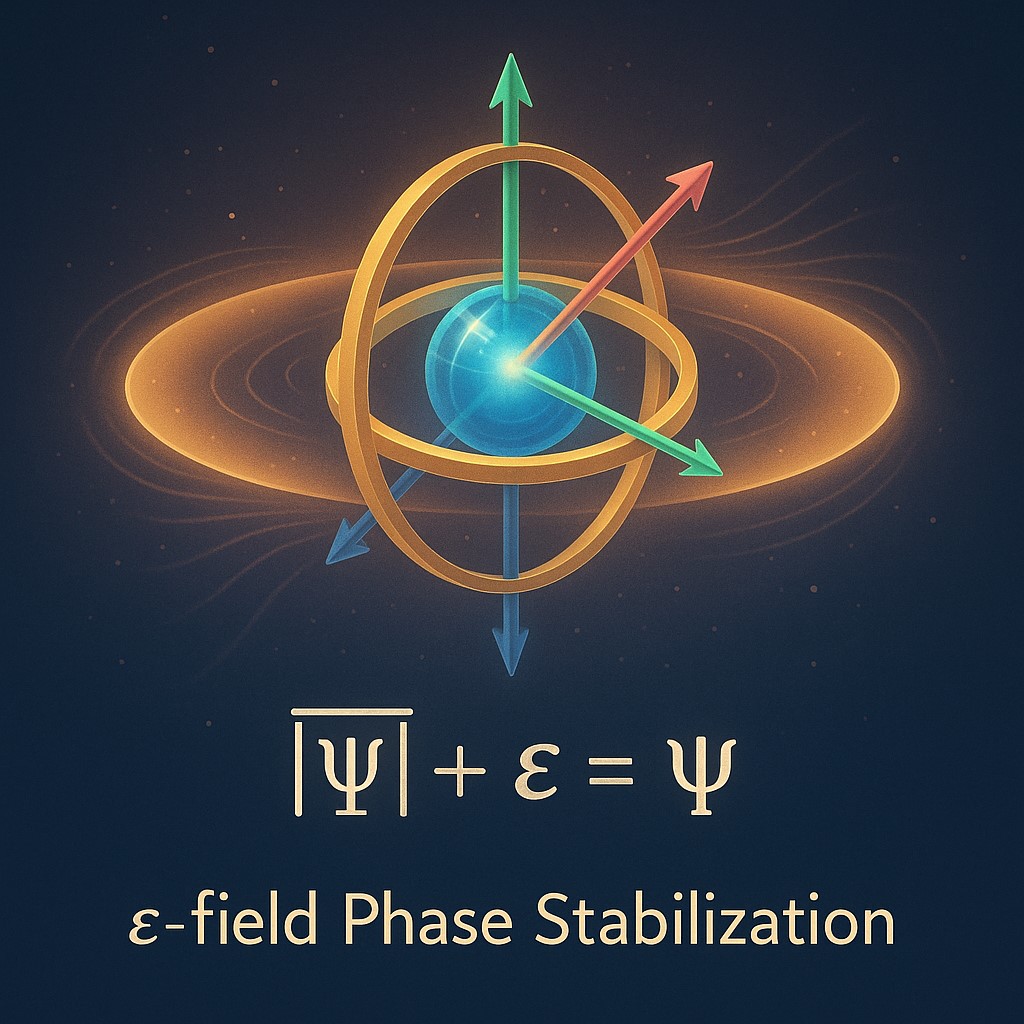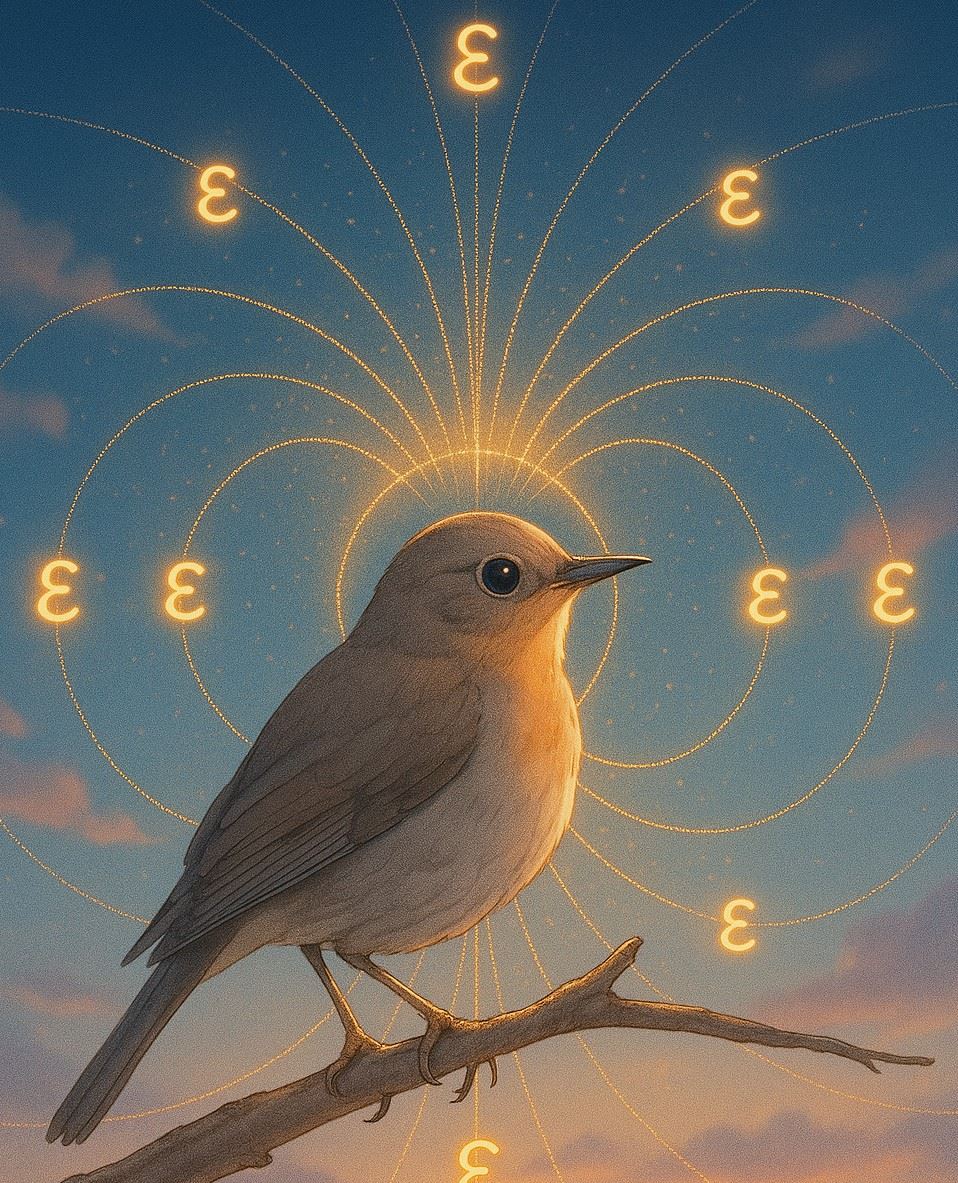Quantum effects like coherence usually vanish in warm environments—yet life sustains them for microseconds. This essay proposes a bold idea: spacetime may have a quaternionic structure with PT symmetry, generating an ε-field that stabilizes quantum states. Coherence becomes a built-in feature of reality, not a fragile anomaly.
Through evolution, life has tuned into this field. Systems like photosynthesis and bird navigation act as quantum antennas, resonating with spacetime’s hidden geometry.
The theory predicts six testable signs—from cosmic expansion drift to lab-based spin echo shifts. If confirmed, they point to a deep geometric link between quantum biology and the fabric of the universe, unifying life, matter, and spacetime under one elegant framework.
A robin orienting under a cloudy sky relies on an internal compass not of gears and springs, but of a fleeting quantum dance. This image, along with other marvels of life from photosynthesis to olfaction, points to a profound mystery. Quantum coherence—a system’s ability to exist in a superposition of multiple states at once—is notoriously fragile in a physics lab, typically erased by the thermal noise of its environment within femtoseconds. Yet, in the warm, wet, and chaotic milieu of a living organism, these quantum effects appear to persist for microseconds or longer.

This juxtaposition of fragility and persistence poses a fundamental question: how can warm biology sustain a genuinely quantum waltz on a classical stage?
This essay proposes that the answer may lie not in molecular accident or evolutionary design alone, but in the very geometry of spacetime. We hypothesize that spacetime is not the conventional four-dimensional manifold of real numbers, but a quaternionic manifold endowed with extra, non-commuting imaginary dimensions and governed by a principle known as Parity-Time (PT) symmetry. This framework naturally gives rise to a built-in geometric field that stabilizes quantum phase relationships. Coherence, in this view, is not a delicate perturbation on reality but a native property of spacetime itself. Decoherence, the seemingly inevitable catastrophe of standard models, becomes a limited, higher-order effect.
Following this introduction, we will explore the biological anomalies that challenge conventional decoherence theory. We will then develop the mathematical structure of PT-symmetric quaternionic spacetime and show how its geometry can extend coherence lifetimes in biological models. Finally, we will propose concrete experimental tests—from modified quantum-sensor protocols to precision biophysical assays—to validate or falsify this hypothesis, aiming to cast new light on the enduring mystery: just how quantum is life?
1. The Puzzle of Warm-Life Coherence: A Ghostly Dance on a Classical Stage
Physics textbooks draw a strict border between the macroscopic classical world and the microscopic quantum realm. The dance of the quantum requires extreme isolation and cold, as even the faintest thermal vibration instantly destroys the delicate phase relationships known as "coherence." This process, called "decoherence," is the bridge from the quantum to the classical, and the bane of every quantum engineer.
It is against this backdrop that discoveries in biology have seemed so perplexing. Life, by all accounts, should be the ultimate classical stage—it is warm, wet, and chaotic. Yet, in this "quantum-forbidden" zone, we have repeatedly glimpsed the tracks of quantum ghosts:
The Plant's Inner Solar Panel: In photosynthesis, the energy from a photon moves as a wave, simultaneously exploring multiple pathways to find the most efficient route to the reaction center with nearly 100% efficiency. The coherence required for this "quantum search" should, in theory, vanish instantly in a warm protein.
The Migratory Bird's Sixth Sense: A bird’s navigation relies on a protein in its eyes called cryptochrome, where a "radical pair" of electron spins acts as a quantum compass. To feel the Earth's faint magnetic field, these spins must maintain their coherence for as long as tens of microseconds
In the thermal chaos of a cell, this is equivalent to asking two snowflakes to hold their positions relative to each other in the middle of a blizzard for hours.
Life's Quantum Shortcut in Chemistry: The astonishing speed of some key enzymatic reactions is explained by quantum tunneling, where particles pass through energy barriers. This shortcut likewise requires wave-like coherence that should be unthinkable in the warm, active site of an enzyme.
These phenomena collectively point to a sharp and profound contradiction. According to standard physics, using typical values from statistical mechanics, the predicted quantum coherence time for a biomolecule at room temperature is about a few trillionths of a second—in other words, around
seconds or less.
But biological reality tells a different story. Experiments reveal coherence lasting much longer— from billionths
to even ten-thousandths
of a second.
This isn’t a minor discrepancy—it’s a gaping mismatch of up to seven orders of magnitude. Existing explanations, such as "environmentally assisted quantum transport," while clever, feel more like patches on a crumbling theoretical edifice. The fundamental puzzle remains unsolved: How does life manage such a long and elegant quantum dance on a stage that ought to be entirely classical? This question compels us to seek a deeper, more unified answer.
2. A New Geometry for Life's Quantum Stage: A Richer Spacetime Canvas
The persistent quantum coherence in biology suggests that conventional models are missing a fundamental stabilizing principle. Here, we propose a cross-disciplinary hypothesis: the very geometry of spacetime extends beyond the familiar, smooth canvas of Einstein's relativity into a richer, more dynamic quaternionic structure, governed by Parity-Time (PT) symmetry. In this framework, quantum states are not fragile glass sculptures, but native, protected colors on the canvas of spacetime itself.
From a Point to a "Gyroscope": What is Quaternionic Spacetime?
Imagine the spacetime we know. In traditional physics, the location of an event (like a flash of light) is described by four real numbers: three for space (length, width, height) and one for time. It's like a static "point" on a map.
Now, let's give this "point" an inner dimension. Imagine that every "point" in spacetime is not just a location, but a tiny, intrinsically spinning gyroscope. This gyroscope has its position in space (the real part), but it also has its own rotational state, described by three mutually perpendicular axes of spin. These three extra, descriptive dimensions of rotation are the three imaginary units (i, j, k) of a quaternion.
So, the coordinate of an "event" in quaternionic spacetime becomes:
Event=(TraditionalSpacetimeLocation)+i(StateofSpinAxis1)+j(StateofSpinAxis2)+k(StateofSpinAxis3)
latex
These extra dimensions are not new spaces we can walk in, but rather an intrinsic, non-commuting "phase flow" or "directionality" at every point of spacetime. Just as a gyroscope's spin has a direction, these dimensions endow spacetime with an inherent dynamism that can interact directly with the phase of a quantum state (the orientation of a quantum wave's vibration).

PT Symmetry: The Law that Keeps the Gyro-World Real
A universe full of tiny, spinning gyroscopes might sound chaotic, potentially wrecking the laws of physics as we know them. This is where PT symmetry comes in. It is a powerful physical principle demanding that the laws of physics remain unchanged under a combined operation of "Parity" (mirroring space) and "Time" reversal.
Applied to our quaternionic spacetime, PT symmetry acts like an invisible calibrator. It ensures that even though the underlying "gyroscopes" (quaternions) are spinning and interacting, all the physical quantities we can actually observe—like distances between objects, the strength of gravity, or the frequency of light—remain stable, real numbers. It filters out the potential chaos of the imaginary dimensions, leaving only their beneficial effects.
The Birth of the ε-Field: A Protective Varnish on the Spacetime Canvas
This PT-calibrated quaternionic spacetime naturally gives rise to a crucial byproduct: a universal field we call the ε-field (epsilon-field).
You can visualize the ε-field as a "protective varnish" or a "phase-stabilizing gel" that comes with the spacetime canvas itself. It arises from the collective spin patterns of the spacetime "gyroscopes"—that is, from the curvature of spacetime. This field is everywhere, permeating every atom and molecule.
When a quantum system (like an electron in a protein) exists, it is no longer fighting a lonely battle against random thermal noise from its surroundings. Instead, it is immersed in this ε-field gel. The job of the ε-field is to continuously "nudge" the quantum state's phase back into alignment, acting like a metronome that guides all quantum waves to vibrate in a coordinated way, thus resisting the disruptions of decoherence.
The evolution of a quantum state is therefore not just a struggle between itself and the environment, but a dance with the geometry of spacetime. We can depict this scenario with a concise equation:
□ψ+εψ=0
latex
This tells us that the evolution of the quantum wave function ψ, besides being governed by traditional physical laws (represented by the curved-space wave operator □), is directly "boosted" or "stabilized" by the ε field.
This hypothesis offers a fundamental shift in perspective: the reason quantum coherence is so robust in life may not be because life is exceptionally clever at building "soundproof rooms," but because the universe itself is a stage with a built-in stabilizer, designed for the quantum dance.

3. How Life Resonates with Spacetime's Rhythm: An Evolutionary Tuning
If quaternionic spacetime truly provides a built-in stabilizing field (the ε-field), like a "phase-stabilizing gel" pervading the universe, the next crucial question is: how did living systems learn to use this exotic resource? The answer may lie in the wisdom of evolution. This section argues that life is not just passively soaking in this field—it has learned, over billions of years, to resonate with it, much like a musician learns to play in concert with the acoustics of a hall.
Molecular Antennas: Tuning to the Cosmic Broadcast
Imagine the ε-field as a cosmic radio station, broadcasting at different "frequencies" and "intensities" at different points in spacetime. This "frequency" corresponds to a specific energy gap. An ordinary molecule, like an untuned radio, would only pick up noisy static (i.e., ambient thermal noise), and its internal quantum states would quickly become scrambled.
But evolution is the ultimate engineer. Through a long process of trial and error, life discovered that certain molecular architectures—like the precise arrangement of pigment molecules in a photosynthetic complex, or the specific conformation of a cryptochrome protein in a bird's eye—have internal quantum transition energies that happen to match the "broadcast frequency" of the local ε-field.
These molecules thereby became highly efficient "quantum antennas."
In photosynthesis, when a photon strikes a chlorophyll molecule, the resulting energy packet (an exciton) no longer tumbles randomly, searching for a path. Instead, it glides along a smooth "phase track" laid down by the ε-field. The energy levels of each pigment molecule in the complex are fine-tuned, acting like relay stations along this track, ensuring the energy wave is transferred to the reaction center with minimal loss and maximum speed. This is why the energy transfer looks more like an elegant wave than chaotic particle collisions.
In the avian compass, the ε-field acts more like a "spin metronome." The electron spins of the radical pair (imagine them as tiny magnetic needles) need to oscillate in sync (coherence) for a time to acutely sense the faint direction of Earth's magnetic field. In a normal liquid environment, collisions from surrounding molecules would act like countless hands, randomly disrupting the rhythm of these tiny needles. The ε-field, however, provides a powerful, unifying background beat. It constantly "corrects" the spins that are about to fall out of step, pulling them back into the collective rhythm. This dramatically extends their coherence time, allowing the bird to clearly "see" the magnetic field lines.

An Evolutionary "Shortcut": Why Resonate with Spacetime?
From an evolutionary standpoint, tapping into the ε-field is an incredibly attractive "shortcut" because it offers a significant thermodynamic advantage.
Building a physical shield to isolate a system from thermal noise, or designing a complex molecular machinery for active error correction, would require immense energy and material resources. It's like building an expensive, perfectly soundproof concert hall for a single performance.
However, if the concert hall itself (spacetime geometry) already has perfect acoustics (the stabilizing effect of the ε-field), then a smart musician (life) only needs to adjust their instrument and playing style (molecular structure and dynamics) to adapt to this environment. This is a far more economical and efficient strategy.
Higher Efficiency: Photosynthesis achieves greater energy conversion efficiency.
Lower Cost: Birds don't need to spend extra metabolic energy to maintain their compass's stability.
Greater Adaptability: Once the trick of resonating with the ε-field is learned, this design principle can be applied to a wide range of biological functions, from enzyme catalysis to olfaction.
Therefore, resonating with spacetime geometry may not have been just an incidental option for evolution, but a path strongly driven by evolutionary pressure. The early life forms that stumbled upon and exploited this "cosmic shortcut" would have gained a decisive advantage in the struggle for survival, embedding this "design principle" deep within the genes of their descendants.
In sum, life does not create its miracles in a vacuum. It is an opportunistic artist that discovered the hidden textures on the canvas of the universe (the ε-field) and learned to paint its masterpieces—stable, efficient, and beautifully quantum life processes—by following them.
4. Putting the Hypothesis to the Test: Six Cross-Scale Signatures
A bold geometric hypothesis, no matter how elegant, must ultimately face the harsh crucible of observation. Our quaternionic-PT framework is not merely a philosophical concept; it is a physical model that makes clear, falsifiable predictions about how the universe works. Its core—a single ε-field—weaves like an invisible thread through every corner of reality. From the grand cosmic web down to a single protein, this field leaves behind six unique “fingerprints.” We will search for these spacetime signatures across six distinct arenas, each one a potential window into the hidden quaternionic structure of spacetime.
Cosmic History: We first examine the history of cosmic expansion. Unlike the static "dark energy" of the standard model, our ε-field evolves. This predicts a tell-tale signature—a subtle but systematic deviation in the expansion rate, particularly around 6-8 billion years ago—a signal that next-generation telescopes are now precise enough to detect.
Galactic Dynamics: Next, we turn to galaxies. The model predicts a "geometric wind" that gently nudges stars in a galaxy's outskirts, adding a slight, universal velocity boost. This would appear as a tiny but consistent anomaly in galactic rotation curves, an effect that mimics dark matter but arises from the geometry of spacetime itself. High-precision star mapping missions can test this.
Neutrino Rhythms: In the subatomic realm, we predict the ε-field alters the quantum rhythm of neutrinos. As they travel vast distances, their oscillation "wavelength" should be slightly stretched, as if a metronome were subtly slowed. Long-baseline neutrino experiments have the power to detect this phase shift, a clear departure from standard particle physics.
Gravitational Wave Echoes: Spacetime itself becomes a "gravitational prism" in our model. When ripples from a black hole merger pass through the ε-field, high-frequency waves should arrive fractions of a second later than low-frequency waves. This predicted "dispersion" effect is a smoking-gun signature that future space-based gravitational wave observatories are perfectly suited to find.
Biophysical Orientation: Returning to the lab, we can test the field's direct influence on life. The quantum coherence of the avian compass protein should not be uniform; it must depend on the molecule's orientation relative to an external field. Observing this "anisotropy"—a spin signal that strengthens or weakens as the sample is rotated—would be direct proof of a background geometric influence.
Resonant Amplification: Finally, we propose a definitive hybrid experiment: turning a biological molecule into a "spacetime antenna." By coupling a photosynthetic molecule to a quantum sensor, we predict that the sensor's coherence will be dramatically amplified when the molecule is "tuned" to a specific frequency—the resonant frequency of the ε-field itself. Observing this sharp "resonance peak" would be tantamount to hearing spacetime's own broadcast.
A Cross-Scale Crucible
Each of these six tests stands on its own, spanning cosmology, astrophysics, particle physics, gravitational waves, biophysics, and quantum sensing. But only one hypothesis—quaternionic spacetime—predicts all six anomalies with the right magnitude and scaling laws. If these seemingly unrelated puzzle pieces fit together perfectly, the simplest and most revolutionary explanation will be that spacetime’s quaternionic geometry is the hidden architect of quantum coherence in life, in galaxies, and across the universe. Conversely, systematic null results in these arenas would compel us to rethink or abandon the ε-field paradigm, returning us to the conventional stage. This is the scientific process: to propose boldly and test rigorously.

5. A Unified Vision of Reality: Rereading Life and Cosmos in Geometry
If future experiments confirm these cross-scale predictions, the impact will extend far beyond physics and biology, painting a new, profoundly unified picture of reality.
From Passive Stage to Active Player: The New Role of Geometry
Since Newton, we have seen spacetime as a passive stage. The quaternionic hypothesis upends this casting. Here, spacetime geometry is an active, central player. The ε-field, a geometric property, acts like an invisible director, setting the tempo for cosmic expansion and personally coaching the quantum dances inside living things. Geometry itself becomes a source of force and information, a modern echo of the ancient idea that the universe is constituted by elegant mathematical principles.
Life: A Resonator of Cosmic Echoes
This new picture also bestows a new meaning upon "life." In the conventional view, life is a "molecular machine" assembled by chance. In our model, it is more akin to a resonator for cosmic echoes. It is not fighting against the universe's chaos, but actively listening and responding to the deepest geometric rhythms of the cosmos. Evolution becomes a billion-year-long process of "tuning" organisms to play more harmoniously with the score provided by spacetime. From this perspective, a robin's navigation or a leaf's photosynthesis may be harnessing an intrinsic property of spacetime. Life ceases to be a lonely stranger and becomes the universe's most exquisite expression.
Breaking the Barriers of Scale and Implications for Our Place in the Universe
Quaternionic geometry offers a magnificent bridge across all scales. The ε-field that pushes galaxies apart is the very same field that stabilizes a protein's spin. The line between the micro and the macro, the living and the non-living, blurs.
Ultimately, this unified vision touches upon the deepest questions about ourselves. If life's operations are deeply entangled with spacetime geometry, then what role does consciousness play? While not solving the hard problem, this model suggests a novel direction. Conscious experience might be a form of deep, dynamic "participation" between the mind, as a complex resonator, and the ε-field of spacetime. Our thoughts may be painted on a far grander geometric canvas than we ever imagined, making us not lonely observers, but integral, active participants in the cosmic story.
Conclusion: A Symphony Composed by Geometry and Life
In the journey of this essay, we began with a seemingly simple biological puzzle: why does the fragile quantum dance persist within the warm, wet environment of a living being? Instead of seeking the answer solely within conventional biochemistry, we took a bold leap across disciplinary boundaries to propose a radical hypothesis: the answer may be hidden in the very structure of spacetime itself. We conjectured that a PT-symmetric quaternionic spacetime, through its intrinsic ε-field, not only drives the grand narrative of the cosmos—from dark energy to galactic dynamics—but also provides a natural, robust sanctuary for the most delicate quantum processes within life.
We have shown that this unified framework is no mere fantasy. It is a rigorous scientific roadmap, guiding us to search for verifiable "spacetime signatures" across six disparate domains. From the subtle drift in cosmic expansion history and the minute anomaly in galactic rotation curves; from the stretched rhythm of neutrino oscillations and the dispersion of gravitational waves; from the peculiar anisotropy of spin echoes in an avian compass to the predicted resonant amplification in a laboratory diamond sensor—these are concrete, falsifiable predictions. Together, they form a decisive crucible: if these independent clues ultimately point to the same geometric origin, we will be forced to concede that the fabric of reality is far stranger and more unified than we had imagined.
Yet, the significance of this hypothesis extends far beyond empirical validation. It offers a profound philosophical shift, inviting us to reconsider the relationship between life and the cosmos. In this picture, life is no longer an accidental byproduct of the cold calculus of physical law, a lonely miracle struggling for survival in an indifferent universe. Instead, life is the highest expression of the universe's intrinsic potential, an active resonator that has learned to listen to and amplify the deepest melodies of spacetime geometry. Consciousness, perception, metabolism—all may be emergent, self-referential patterns within this grand geometric structure, weaving biological agency deep into the warp and weft of spacetime.
This vision dissolves the artificial barriers between physics and biology, the micro and the macro, mind and cosmos, leading us toward a monistic, quantum-geometric worldview. In this worldview, all seemingly unrelated phenomena—the spin of a galaxy, the breath of a leaf, the flight of a bird, the thought of a human—are but different movements of the same cosmic symphony, played on different instruments.

Whether this grand geometric paradigm ultimately withstands the scrutiny of future experiments or yields to a more complete theory in the face of new evidence, the journey of inquiry it embodies—the very courage to fuse general relativity, quantum mechanics, biology, and philosophy—exemplifies the true spirit of foundational scientific exploration.
By asking, "How quantum is life?", we are probing not just the behavior of molecules, but the very nature of spacetime itself. In this dance between geometry and life, we may finally discover the harmonious rhythm that connects galaxies and genomes, quanta and qualia. And in that moment, we will no longer be mere observers of the universe, but will truly realize that we ourselves are the song of existence that the universe is singing.